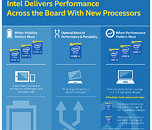- Joined
- Oct 9, 2007
- Messages
- 47,670 (7.43/day)
- Location
- Dublin, Ireland
| System Name | RBMK-1000 |
|---|---|
| Processor | AMD Ryzen 7 5700G |
| Motherboard | Gigabyte B550 AORUS Elite V2 |
| Cooling | DeepCool Gammax L240 V2 |
| Memory | 2x 16GB DDR4-3200 |
| Video Card(s) | Galax RTX 4070 Ti EX |
| Storage | Samsung 990 1TB |
| Display(s) | BenQ 1440p 60 Hz 27-inch |
| Case | Corsair Carbide 100R |
| Audio Device(s) | ASUS SupremeFX S1220A |
| Power Supply | Cooler Master MWE Gold 650W |
| Mouse | ASUS ROG Strix Impact |
| Keyboard | Gamdias Hermes E2 |
| Software | Windows 11 Pro |
In order to help people understand the level of processor performance and make an informed purchase decision based on their needs, Intel Atom processors will now be offered in three distinct brand levels in a good/better/best construct - the Intel Atom x3, x5 and x7 processors. This change will start with the next generation of processors. Intel Atom x3 processor provides basic, but genuine Intel-level tablet, phablet and smartphone performance.
Intel Atom x5 processor has more capabilities and features for people who want an even better experience, and the flagship Intel Atom x7 processor provides the highest level of performance and capabilities for the Intel Atom family. The Intel Atom processor is designed to provide the best battery life with great performance for tablets, phablets, smartphones and other mobile devices. This infographic lists Intel's consumer brand portfolio for consumer devices including the Intel Core processor, Intel Core M processor, Intel Atom processor, Intel Pentium processor and Intel Celeron processor.

View at TechPowerUp Main Site
Intel Atom x5 processor has more capabilities and features for people who want an even better experience, and the flagship Intel Atom x7 processor provides the highest level of performance and capabilities for the Intel Atom family. The Intel Atom processor is designed to provide the best battery life with great performance for tablets, phablets, smartphones and other mobile devices. This infographic lists Intel's consumer brand portfolio for consumer devices including the Intel Core processor, Intel Core M processor, Intel Atom processor, Intel Pentium processor and Intel Celeron processor.

View at TechPowerUp Main Site






